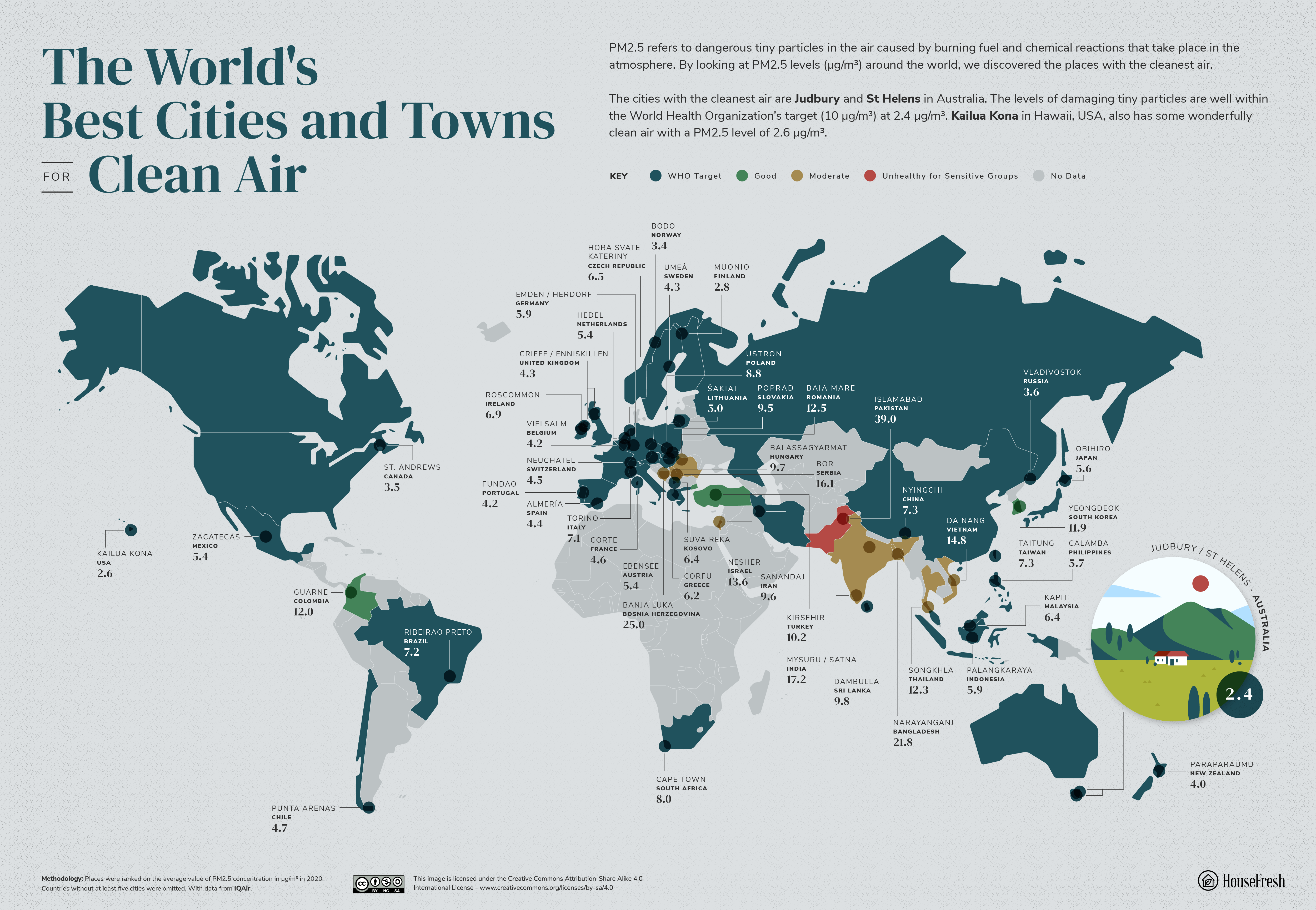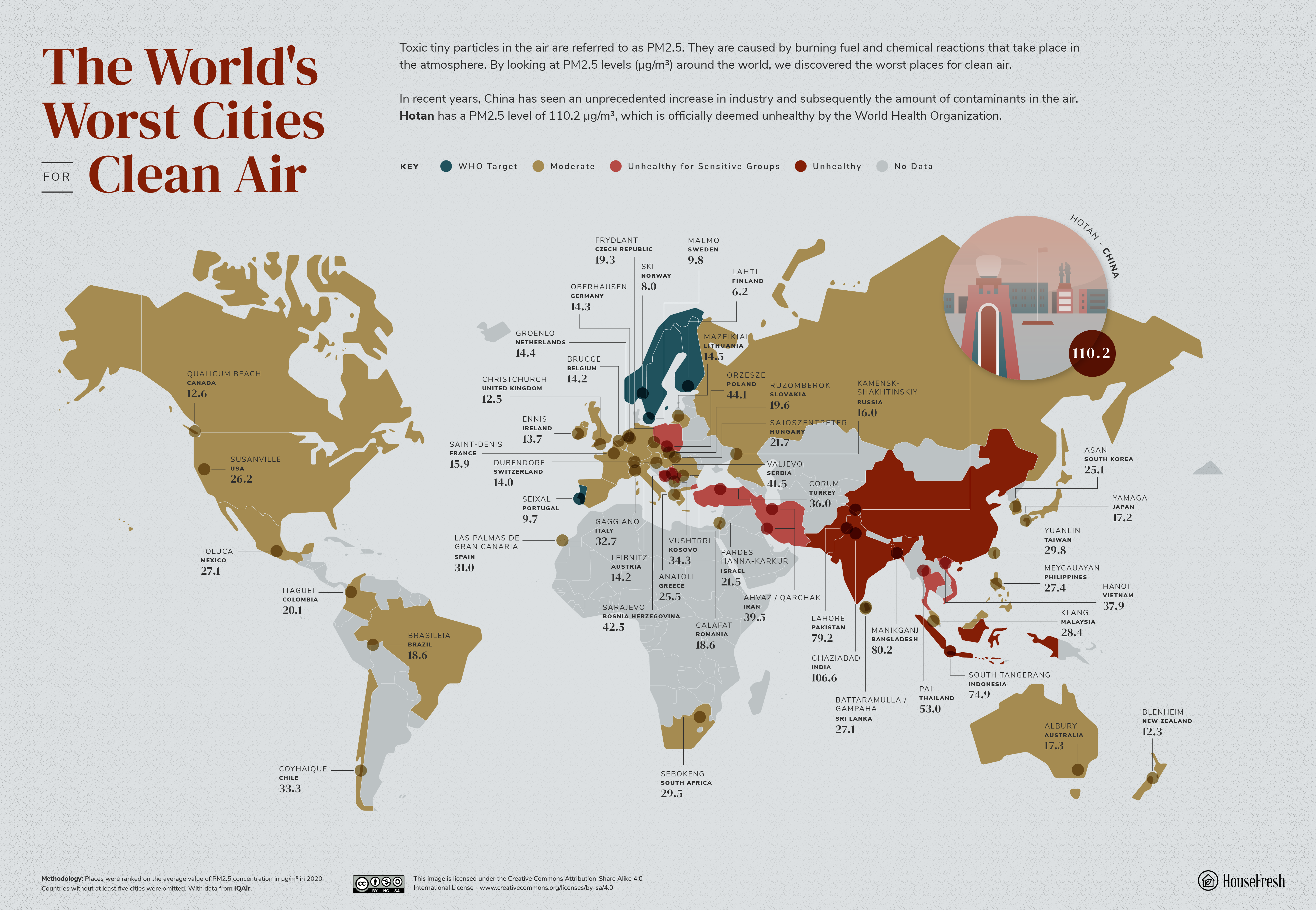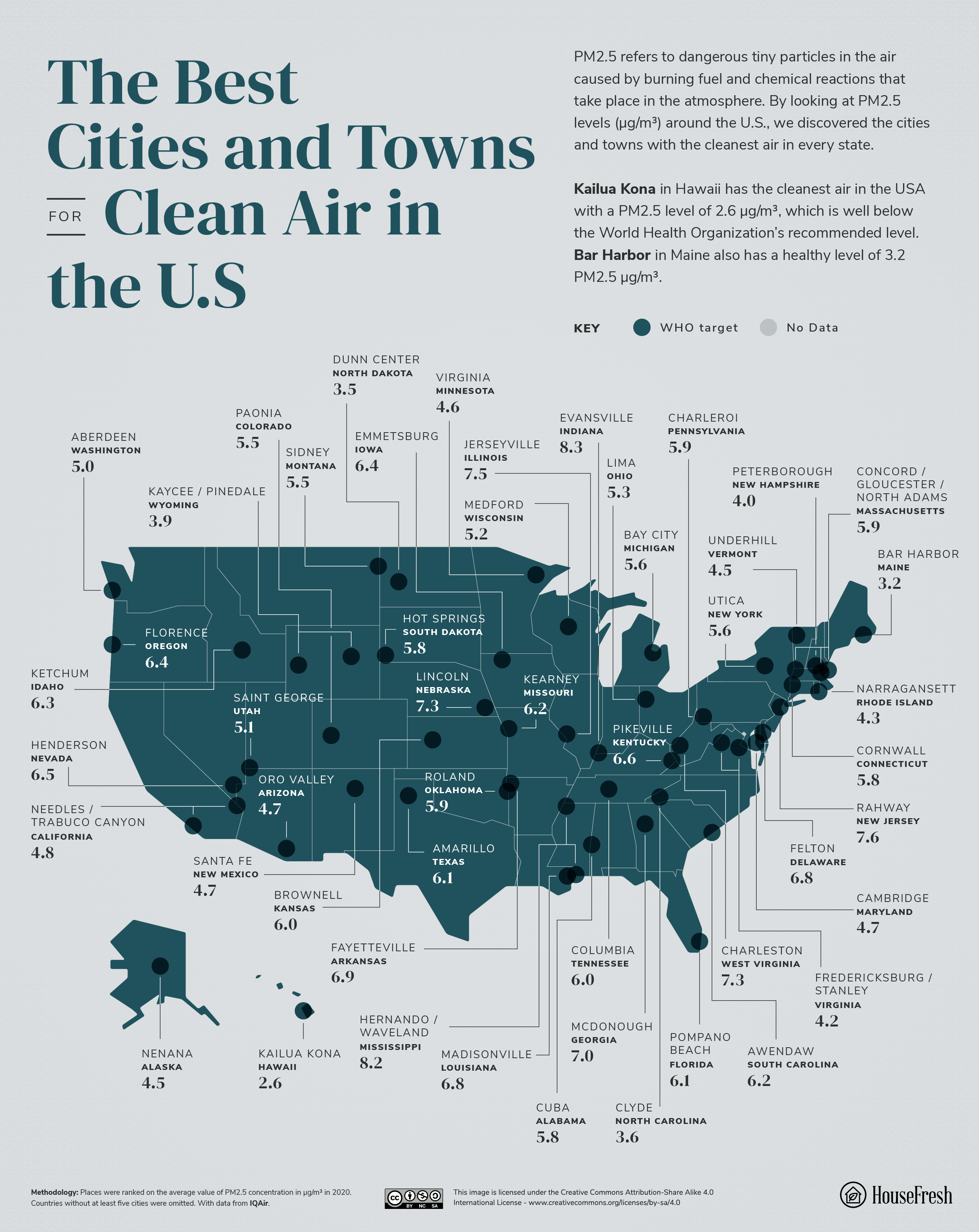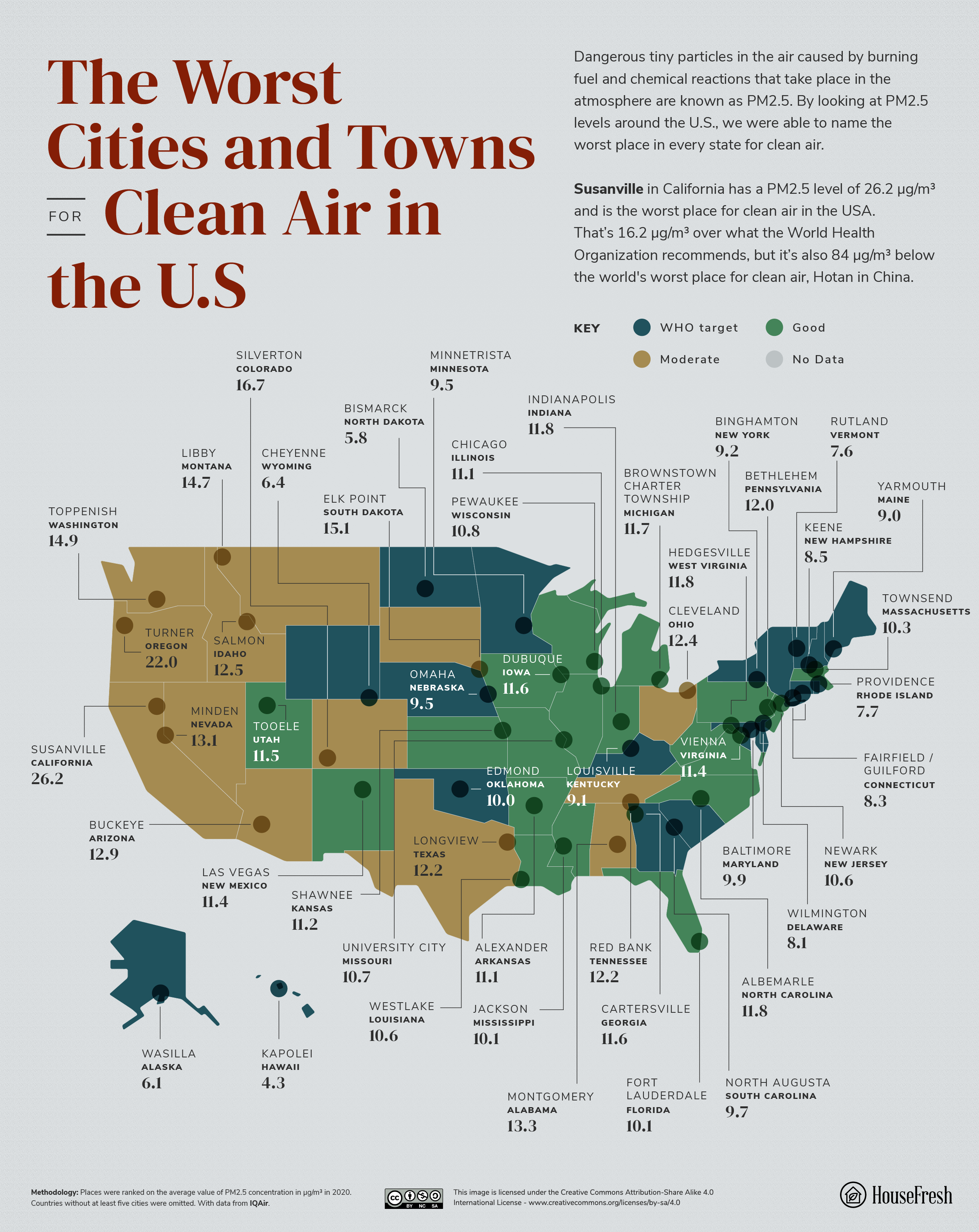Despite advances in technology which allows machinery and factories to burn fuel cleaner and be more environmentally friendly, the truth is that air pollution rates have risen over the years as the inevitable consequence of globalization — and many of us often take for granted the air which we breathe…
Towns and Cities Around The World With the Cleanest — and Dirtiest — Air?

…but if you take a deep breath and did not break out in a fit of coughing, you are one of the more fortunate ones, as approximately seven million people die prematurely each year from air pollution — and 600,000 of them are children. Poor air quality is linked to respiratory illnesses, leukemia, heart disease, strokes, and breast cancer.
In comparison, the latest statistics are that at least 4,067,517 people — or slightly less than 2.19 percent — have died of the minimum of 188,655,968 confirmed cases worldwide during the past 19 months, according to this situation dashboard from the World Health Organization pertaining to the 2019 Novel Coronavirus…
…and at the same time, at least 4,075,517 people — or slightly less than 2.19 percent — have died of the minimum of 189,540,653 confirmed cases worldwide during the past 19 months, according to this situation dashboard from Johns Hopkins University & Medicine pertaining to the 2019 Novel Coronavirus.
What Exactly is Polluting Our Air — and How Do We Measure It?

The comparison of those statistics may be enough to cause you to choke — but what exactly is polluting our air; and how do we measure it? Air pollution encompasses more than what we can see, feel, and smell. Emissions from vehicles, fossil fuels, chemical production, and power generation all play a part in releasing hazardous substances into our environment. Even natural events — such as volcanic eruptions and methane from decomposing organic matter — contribute to air quality.
The Air Quality Index — or AQI — is a gauge that grades air quality from 0 all the way to above 300; or from good to hazardous. With the help of the World Air Quality Report 2020 by IQAir, a comprehensive look into how we have been doing for the last year was given. The data about the best and worst places for clean air was collected using IQAir. Cities and towns were ranked on the average value of PM2.5 concentration in µg/m³ in 2020. Countries without at least five cities were omitted.
I have been given express written permission to use the maps and the verbatim text from this article written by Amy Ashton for HouseFresh, which highlights what are purported to be the cities and towns around the world with the cleanest air — as well as those with the dirtiest air. While HouseFresh has endeavored to ensure the information provided is accurate and current, it cannot guarantee it. Neither HouseFresh nor The Gate accept liability for the information which is presented in this article.
Key Findings
- Bangladesh takes the top spot as the most polluted country, followed by Pakistan, India, and Mongolia.
- 49 of the 50 most polluted cities worldwide were in Bangladesh, Pakistan, China, and India.
- Japanese city Obihiro was Asia’s top city for clean air with a PM2.5 of 5.6µg/m3.
- Judbury (Australia), Kailua Kona (U.S.A.), and Muonio (Finland) were the cities with the cleanest air.
- Susanville in wildfire-ravaged California had the dirtiest air in America with a PM2.5 of 26.2µg/m3.

The top three cities in the world with the best air were Judbury (Australia) with a PM2.5 of 2.4µg/m3, Kailua Kona (U.S.) with a PM2.5 of 2.6µg/m3 followed by Muonio (Finland) with a PM2.5 of 2.8µg/m3. Not surprisingly, Judbury is a rural Tasmanian region with a population size of only 392. Likewise, Muonio is only home to 2,308 people. Kailua Kona in Hawaii is the largest of the three, with a population of 11,975.

Natural disasters impact air quality levels significantly. Hotan (Xinjiang, China) was the most polluted city in the world in 2020 with a PM2.5 of 110.2µg/m3, a finding that has largely been attributed to local sandstorms, given its location at the southwestern edge of Taklimakan Desert, the world’s largest shifting sand desert. Ghaziabad (Uttar Pradesh, India) is the second most polluted city in the world with a PM2.5 of 106.6µg/m3. Colloquially known as the gateway to its home state, massive traffic volumes were likely the cause of the high levels of air pollution.
Manikganj (Bangladesh) lies in third place, with a PM2.5 of 80.2µg/m3. As one of the fastest developing countries around the world, with its industrial sector growing at a rate of 13% per year, vehicles and industrial emissions are the major contributors to air pollution in this country of 165 million people.
Kailua Kona, Hawaii, had America’s Cleanest Air in 2020
The cleanest city award in North America went to tropical island city Kailua Kona, Hawaii, with a PM2.5 of 2.6µg/m3. According to IQAir, the U.S. emerged as the 22nd country with the cleanest air out of 106 countries. Home to 328 million people, the U.S. scored a healthy average AQI of 40 in 2020.
Bar Harbor in Maine came in second with an average PM2.5 of 3.2µg/m3, followed by Dunn Center in North Dakota with a PM2.5 of 3.5µg/m3. Bar Harbor is a popular tourist destination boasting the largest parts of Acadia National Park, while Dunn Center is a tiny town of only 146 people.

2020 marked the 50th anniversary of the U.S. Clean Air Act in 1970, which put into place comprehensive federal and state regulations that aimed to cut down air pollution. As of 2019, the Environmental Protection Agency (EPA) reports a 77% drop in air pollutants while the country experienced a growth in the gross domestic product by 324%.
Banning lead from motor vehicle gasoline was a key achievement of the Clean Air Act. Removing thousands of tons of lead from the air is projected to have prevented 205,000 early deaths and 10.4 million lost I.Q. points in children, which would have resulted from continued lead exposure.
Improved air quality also helped preserve our forests, aquatic life, and soil. The agricultural industry enjoyed boosted crop and timber yields, benefits which were estimated to be worth $5.5 billion in 2010.
Susanville, California, was the Worst American City for Clean Air in 2020
Despite the nationwide lockdowns due to the COVID-19 pandemic, 38% of U.S. cities failed to meet the WHO PM2.5 targets, a considerable increase from the 21% seen in 2019. However, 2020 also saw the country’s largest wildfire in over 18 years.
As a result, Susanville, California, found itself the most polluted city in America, with a PM2.5 of 26.2µg/m3. What’s more, California was the home of 24 of the 25 worst cities for PM2.5 pollution. Wildfires burned 4.2 million acres of land cumulatively in California alone and were reported to contribute as high as 70% of particulate pollution on any given day.
After California, Turner in Oregon came in second with a PM2.5 of 22µg/m3. Silverton in Colorado came in third with a PM2.5 of 16.7µg/m3. Silverton lays claim to several notable disasters in the 20th century. Its most recent one is the Gold King Mine disaster in 2015, where the EPA and its contractors accidentally released 1 million gallons of mine wastewater into the Animas River.

Although the U.S. has made significant progress in combating air pollution, there is still room for improvement. Climate change resulting from greenhouse gas accumulation and thinning of the ozone layer causes more severe wildfires, worsened drought, heavier rains, and floods, as well as more intense hurricanes and storms. Natural disasters confer tumultuous effects on livelihoods, communities, and the nation’s economy.
In addition to EPA’s stricter enforcement of vehicle and industrial emissions, the U.S. is also working with the rest of the world via the international Montreal Protocol to phase out the production of ozone-destroying substances such as hydrochlorofluorocarbons (found in refrigerants and air conditioning).
Clean Air Inside and Out — The Embodiment of Good Health
The American Lung Association State of the Air 2021 report found that despite nationwide efforts in controlling air pollution, more than 40% of Americans – over 135 million people – are still living in areas with unhealthy particulate pollution and ozone levels.
9 out of 10 urban dwellers are affected by air pollution. Children are particularly at risk of air impurities, with even low levels of PM2.5µg/m3 exposure linked to structural changes in their developing brains. Additionally, children whose mothers were exposed to high levels of particulate matter during pregnancy are more at risk of autism, attention-deficit and hyperactivity disorder (ADHD), and low birth weight.
It is crucial for you to ensure that the air that you and your loved ones are breathing in is clean. Indoor air quality (air inside buildings and structures) relates closely to our well-being. Indoor air purification is shown to improve indoor PM2.5 concentrations (11). The EPA recommends the use of centralized or portable air filters to ventilate the home and to reduce air pollutants.
Key features that a good air filter should have are:
- A high-efficiency particulate air (HEPA) filter for particle filtration.
- An efficient low leakage system.
- An activated carbon filter for gas and odor filtration.
Stay vigilant and get involved in your lung health today before it’s too late.
Summary

I fully support whatever we can reasonably do to live in a greener and more environmentally friendly world — without sending the world economy into a tailspin, which is what the current 2019 Novel Coronavirus pandemic was allowed to do — and that includes ensuring that the air is as clean as possible for everyone to breathe.
As I am based in the state of Georgia, I have a difficult time believing that McDonough has the cleanest air in the state, while Cartersville has the dirtiest air. I would think that many areas of the mountains in northern Georgia has cleaner air; and I know of some areas of the state which are quite industrial…
…and where is Brooklyn? Why has that borough not been included in this article? Was it so polluted that it was off the charts — or was it so clean that it was too unbelievable?
Traveling around the world had me see areas with rather poor air quality — such as Shanghai and Los Angeles. I have also been to places where the air quality seemed amazingly clean — such as Nenana in Alaska, which is mentioned as having the cleanest air in the state…
…but I do not agree with all of the findings in this article — which is where you come in: with what parts of this article do you agree; with what parts do you disagree; and to how many of the cities and towns which are mentioned in this article have you been?
All photographs ©2011, ©2014, and ©2015 by Brian Cohen.

